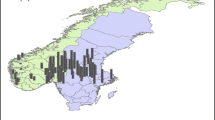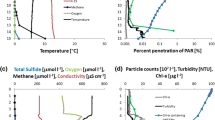Abstract
The vertical distribution of dissolved greenhouse gases (CH4,ΣCO2 and N2O), NO\({\text{NO}}_{\text{2}} - \),and δ13C of ΣCO2 in Lake Biwa during a stagnantperiod was precisely determined. ΣCO2 as well as NO\({\text{NO}}_{\text{3}} - \)was accumulated in the hypolimnion, whereas NO\({\text{NO}}_{\text{2}} - \) and CH4concen\-trations were generally higher in theepilimnion than in the hypolimnion. In August, NO\({\text{NO}}_{\text{2}} - \) andCH4 were ephemerally accumulated at the thermocline. Theconcentration of CH4 always exceeded equilibrium with respectto air/water exchange. N2O was rather uniformly distributed inboth time and space, and remained near equilibrium with respect toair/water exchange. All of these observations are similar to otherstratified, oligotrophic lakes, in which the hypolimnia were welloxygenated. The δ13C of ΣCO2 became morenegative with increasing depth, and showed a strong negativecorrelation with apparent oxygen utilization. From the data, the δ13Cvalue of organic matter decomposed into ΣCO2 inthe hypolimnion was calculated by isotope mass-balance, and found tobe in a similar range to δ13C of phytoplankton and benthic algaeand distinctively higher than δ13C of both terrestrial andsedimentary organic matters. This suggests that autochthonous organicmatter was the major source of ΣCO2.
Similar content being viewed by others
References
Boschker HT, Dekkers EMJ, Pel R & Cappenberg ThE (1995) Sources of organic carbon in the littoral of Lake Gooimeer as indicated by stable carbon isotope and carbohydrate compositions. Biogeochemistry 29: 89–105
Bower CE & Holm-Hansen T (1980) A salicylate-hypochlorite method for determining ammonia in sea water. Can. J. Fish. Aquat. Sci. 37: 794–798
Elkins JW, Wofsy SC, McElroy MB, Kolb CE & Kaplan WA (1978) Aquatic sources and sinks for nitrous oxide. Nature 275: 602–606
Fry B & Sherr EB (1988) δ13C measurements as indicators of carbon flow in marine and freshwater ecosystems. In: Rundel PW(Ed) Stable isotopes in ecological research (pp 196–229). Springer, Berlin.
Goreau TJ, Kaplan WA, Wofsy SC, McElroy MB, Varois FW & Watson SW(1980) Production of NO2 ― and N2Oby nitrifying bacteria at reduced concentrations of oxygen. Appl. Environ. Microbiol. 40: 526–532
Hedges JI, Clark WA & Cowie GL (1988) Fluxes and reactivities of organic matter in a coastal marine bay. Limnol. Oceanogr. 33: 1137–1152
Kaplan WA & Wofsy SC (1985) The biogeochemistry of nitrous oxide: A review. Adv. Aquat. Microbiol. 3: 181–206
Kawashima M, Konishi K, Okuda H, Kinose K, Itasaka O & Hori T (1976) On the water quality of Lake Biwako-relations between chlorophyll aand nutrients and COD. Mem. Fac. Educ. Shiga Univ. Nat. Sci. 26: 11–18
Knowles R, Lean DRS & Chan YK (1981) Nitrous oxide concentrations in lakes: Variations with depth and time. Limnol. Oceanogr. 26: 855–866
Lehman JT (1988) Hypolimnetic metabolism in Lake Washington: Relative effects of nutrient load and food web structure on lake productivity. Limnol. Oceanogr. 33: 1334–1347
Lemon E & Lemon D (1981) Nitrous oxide in freshwaters of the Great Lakes Basin. Limnol. Oceanogr. 26: 867–879
McKenzie JA (1985) Carbon isotopes and productivity in the lacustrine and marine environment. In: Stumm W (Ed) Chemical processes in lakes (pp 99–118). Wiley-Interscience, New York
Meyers PA (1994) Preservation of elemental and isotopic source identification of sedimentary organic matter. Chem. Geol. 114: 289–302
Miyajima T (1992) Decomposition activity and nutrient regeneration rates in the hypolimnion of the north basin of Lake Biwa. Jpn. J. Limnol. 53: 65–73
Miyajima T (1994) Mud-water fluxes of inorganic nitrogen and manganese in the pelagic region of Lake Biwa: Seasonal dynamics and impact on the hypolimnetic metabolism. Arch. Hydrobiol. 130: 303–324
Miyajima T, Nakano S & Nakanishi M (1995) Planktonic diatoms in pelagic silicate cycle in Lake Biwa. Jpn. J. Limnol. 56: 211–220
Miyajima T, Yamada Y, Hanba YT, Yoshii K, Koitabashi T & Wada E (1995) Determining the stable isotope ratio of total dissolved organic carbon in lake water by GC/C/IRMS. Limnol. Oceanogr. 40: 994–1000
Mook WG, Bommerson JC & Staverman WH (1974) Carbon isotope fractionation between dissolved bicarbonate and gaseous carbon dioxide. Earth Planet. Sci. Lett. 22: 169–176
Murphy J & Riley JP (1962) A modified single solution method for the determination of phosphorus in natural waters. Anal. Chim. Acta 27: 31–36
Oana S & Deevey ES (1960) Carbon 13 in lake waters, and its possible bearing on paleolimnology. Am. J. Sci. 258-A: 253–272
Oremland RS (1988) Biogeochemistry of methanogenic bacteria. In: Zehnder AJB (Ed) Biology of Anaerobic Microorganisms (pp 641–705). Wiley-Liss, New York
Rodhe H (1990) A comparison of the contribution of various gases to the greenhouse effect. Science 248: 1217–1219
Rudd JWM & Hamilton RD (1975) Factors controlling rates of methane oxidation and the distribution of the methane oxidizers in a small stratified lake. Arch. Hydrobiol. 75: 522–538
Rudd JWM, Furutani A, Flett RJ & Hamilton RD(1976) Factors controlling methane oxidation in a shield lake: The role of nitrogen fixation and oxygen concentration. Limnol. Oceanogr. 21: 357–364
Scheiner D (1974) A modified version of the sodium salicylate method for analysis of waste water nitrate. Water Res. 8: 835–840
Schmidt U & Conrad R (1993) Hydrogen, carbon monoxide, and methane dynamics in Lake Constance. Limnol. Oceanogr. 38: 1214–1226
Tezuka Y (1984) Seasonal variations of dominant phytoplankton, chlorophyll a, and nutrient levels in the pelagic regions of Lake Biwa. Jpn. J. Limnol. 45: 26–37
Tezuka Y (1990) Bacterial regeneration of ammonium and phosphate as affected by the carbon:nitrogen:phosphorus ratio of organic substrates. Microb. Ecol. 19: 227–238
Ueda S, Ogura N & Yoshinari T (1993) Accumulation of nitrous oxide in aerobic groundwaters. Water Res. 27: 1787–1792
Vincent WF & Downes MT (1981) Nitrate accumulation in aerobic hypolimnia: Relative importance of benthic and planktonic nitrifiers in an oligotrophic lake. Appl. Environ. Microbiol. 42: 565–573
Wada E & Hattori A (1971a) Spectrophotometric determination of traces of nitrite by concentration of azo dye on an anion-exchange resin: Application to sea waters. Anal. Chim. Acta 56: 233–240
Wada E & Hattori A (1971b) Nitrite metabolism in the euphotic layer of the Central North Pacific Ocean. Limnol. Oceanogr. 16: 766–722
Yoshinari T (1976) Nitrous oxide in the sea. Mar. Chem. 4: 189–202
Author information
Authors and Affiliations
Rights and permissions
About this article
Cite this article
MIYAJIMA, T., YAMADA, Y., WADA, E. et al. Distribution of greenhouse gases, nitrite, and δ13C of dissolved inorganic carbon in Lake Biwa: Implications for hypolimnetic metabolism. Biogeochemistry 36, 205–221 (1997). https://doi.org/10.1023/A:1005702707183
Issue Date:
DOI: https://doi.org/10.1023/A:1005702707183




